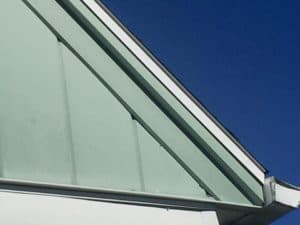 Of all of the ways that contractors can drive up their profits, skipping the drip edge flashing is unwise and is likely to hurt the homeowner down the road.
Of all of the ways that contractors can drive up their profits, skipping the drip edge flashing is unwise and is likely to hurt the homeowner down the road.
Drip edge is a piece of flashing that goes on the gable ends (also known as rake ends) of a home. Sometimes fly by night contractors use it in place of gutter apron, which is another type of flashing we will cover in another article.
The main purposes of drip edge, also known as d-edge, is to extend the shingle out and away from the edge of the gable. Houses that are in communities that have neighborhood covenants sometimes do not use drip edge, mostly because the builder decided to pocket a couple hundred dollars per roof rather than do right by his customers. These are usually communities that have cedar shake roofs.
As an alternative to using drip edge

Drooping soffit and fascia
flashing, some contractors will simply extend the shingle out an inch past the edge of the roof. However, asphalt shingles can, under heat, sag or droop. This looks like poor craftsmanship when the alternative is used, but some contractors justify taking this shortcut in order to be more competitive. After all, most customers won’t know the difference.
Drip edge is available in an array of colors. It is not simply a choice of white or brown. However, it does take some planning for a contractor to order and have delivered, the proper amount for a job site.
Finally, if your house has aluminum clad fascia rather than painted fascia, drip edge is a great way to hold the top of that fascia down. While drip edge is supposed to be nailed down from the roof, fascia is nailed on a vertical surface. By using drip edge, the top of the fascia can be pulled tight against the wood underneath it and be much less susceptible to blow off or wind damage. If you don’t have drip edge, and wind or water gets behind it, it can pull the metal back, allow water infiltration.

